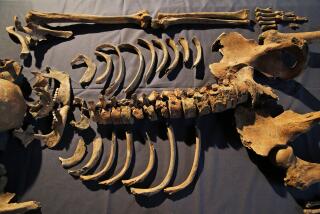A pest to royalty, philosophers and plain folks too
The ancient Egyptian penchant for wigs -- think Cleopatra’s bejeweled jet-black sheath -- was inspired partly by art, partly by public health. Ancient Egypt, Rome and Greece, and other civilizations too, were awash in the same lice and nits that infest the heads of millions of American schoolchildren each year.
*
Elena Conis
*
Head lice are about as old as human parasites get. Archeologists have turned them up on Chinese, Peruvian and Egyptian mummies and at a site in Brazil dating back more than 10,000 years.
The ancients managed their lice by suffering through them, combing them out, affectionately picking them off each other’s heads, dousing them in oil, or simply shaving. (Thus the wigs.) Still plagued by lice in the Middle Ages and later, doctors added mercury, gasoline and sulfur baths to the list, and crafted nit combs of bone, antler and boxwood.
For centuries, many believed the bugs spontaneously generated from human skin; were caused by strange diets, habits, heat or moisture; or were sent by divinities to punish bad behavior. Plato, Socrates, King Herod and the Roman dictator Sulla were all accused of having lice, and an ancient Greek proverb stated that a beard signified lice, not brains.
The early Christians spread rumors that lice had killed many a Roman emperor, capitalizing on a by-then widespread belief that the bugs were sent by God to smite the corrupt.
Irritating as they are, head lice don’t serve as agents of death. But the body louse, a distinct species that disdains the human head in favor of bedding and clothing, can spread deadly diseases such as typhus -- a discovery that won scientist Charles Nicolle a Nobel Prize in 1928.
Some scientists now speculate that such bacteria-ridden lice may have hobbled Napoleon’s troops on their march into Russia: Last year, researchers reported that one-third of his soldiers buried in a Lithuanian mass grave had been infected with louse-born diseases.
As age-old companions, lice have made their marks on the English language. A louse was once just a louse, but by the 1500s it meant a worthless person too. Similar linguistic journeys resulted in “lousy” meaning just plain bad (and not necessarily louse-infested); to “louse up” meaning to “mess up”; and to “nitpick,” meaning to niggle about all the barely visible entities one can.
In recent years, molecular biologists have used DNA techniques to reveal that lice have been loyal to their human hosts for perhaps far longer than most would guess: more than 5 million years. When humans split from their ancestral chimps around that same time, each species acquired its own louse. And when humans adopted clothing, lice adapted, spawning the body louse as a brand new species that takes up residence in the seams of fabric.
Shaven or unshaven, naked or clothed, armed with insecticides or just plain olive oil, humans have been unable to shake the hardy louse. As long as people walk on Earth, lice, it appears, will be walking on them.




